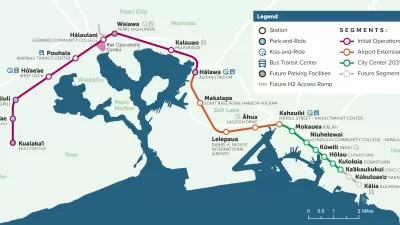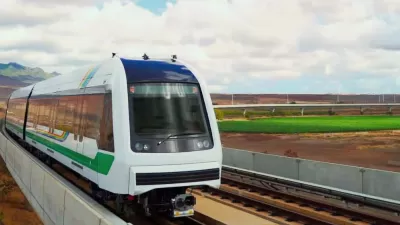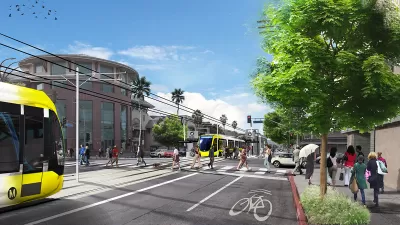The Federal Transit Administration was withholding funding for the beleaguered Honolulu Rail Transit project until the Honolulu Authority for Rapid Transportation came up with a financial plan to get the project to its long-delayed completion.

"The rail authority expects to collect $188 million more in taxes than previously projected to help finance the Honolulu rail project, but the city is still making plans to cut costs if necessary, including possibly deferring construction of the $315 million Pearl Highlands Parking Structure and Transit Center," according to an article by Kevin Dayton that might be behind a pay wall for some readers.
A non-pay walled version of the story is available on the Mass Transit magazine website. The article provides details into the Honolulu Authority for Rapid Transportation's recovery plan for the project as a response to a 30-day deadline set at the end of September by the Federal Transit Administration.
Cost-cutting steps listed in the recovery plan include "eliminating lighting between stations along the 20-mile rail line, modifying sound barriers downtown and redesigning the overhead canopies that will provide shelter at the eight urban Honolulu rail stations, according to a draft plan," reports Dayton.
"The FTA committed to provide $1.55 billion in federal funding to help Honolulu build the rail line, but has withheld nearly $744 million of that money until the Honolulu Authority for Rapid Transportation develops an acceptable recovery plan," adds Dayton. Another article from September details the FTA's decision to withhold the funding when it set the deadline in September.
FULL STORY: Rail draft plan reveals potential cost-cutting measures

Planetizen Federal Action Tracker
A weekly monitor of how Trump’s orders and actions are impacting planners and planning in America.

San Francisco's School District Spent $105M To Build Affordable Housing for Teachers — And That's Just the Beginning
SFUSD joins a growing list of school districts using their land holdings to address housing affordability challenges faced by their own employees.

The Tiny, Adorable $7,000 Car Turning Japan Onto EVs
The single seat Mibot charges from a regular plug as quickly as an iPad, and is about half the price of an average EV.

Seattle's Plan for Adopting Driverless Cars
Equity, safety, accessibility and affordability are front of mind as the city prepares for robotaxis and other autonomous vehicles.

As Trump Phases Out FEMA, Is It Time to Flee the Floodplains?
With less federal funding available for disaster relief efforts, the need to relocate at-risk communities is more urgent than ever.

With Protected Lanes, 460% More People Commute by Bike
For those needing more ammo, more data proving what we already knew is here.
Urban Design for Planners 1: Software Tools
This six-course series explores essential urban design concepts using open source software and equips planners with the tools they need to participate fully in the urban design process.
Planning for Universal Design
Learn the tools for implementing Universal Design in planning regulations.
Smith Gee Studio
City of Charlotte
City of Camden Redevelopment Agency
City of Astoria
Transportation Research & Education Center (TREC) at Portland State University
US High Speed Rail Association
City of Camden Redevelopment Agency
Municipality of Princeton (NJ)





























